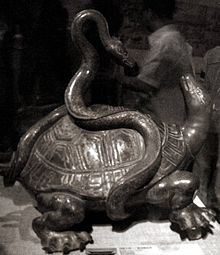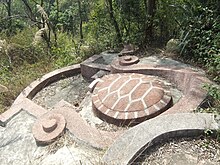Black Turtle-Snake
| Black Turtle-Snake | |||||||||||||||
|---|---|---|---|---|---|---|---|---|---|---|---|---|---|---|---|
 The Black Tortoise depicted on a Chinese tile | |||||||||||||||
| Chinese name | |||||||||||||||
| Chinese | 玄武 | ||||||||||||||
| Literal meaning | Mysterious ~ Dark ~ Black Warrior | ||||||||||||||
| |||||||||||||||
| Vietnamese name | |||||||||||||||
| Vietnamese alphabet | Huyền Vũ | ||||||||||||||
| Chữ Hán | 玄武 | ||||||||||||||
| Korean name | |||||||||||||||
| Hangul | 현무 | ||||||||||||||
| Hanja | 玄武 | ||||||||||||||
| |||||||||||||||
| Japanese name | |||||||||||||||
| Kanji | 玄武 | ||||||||||||||
| Hiragana | げんぶ | ||||||||||||||
| |||||||||||||||
| Black Warrior of the North | |||||||
|---|---|---|---|---|---|---|---|
 A copper Black Tortoise from the Yongle era of the Ming dynasty (early 15th century) | |||||||
| Chinese | 北方玄武 | ||||||
| |||||||
The Black Tortoise is one of the Four Symbols of the Chinese constellations. It is usually depicted as a tortoise intertwined with a snake.[1] The character '武' can mean 'martial' or 'warrior.' The two characters 玄 and 武 do not have any literal meaning of tortoise and snake. But both tortoise and snake are known to hibernate during winter. The image of intertwined tortoise and snake likely symbolizes a state of inner struggle[citation needed] or a state of hibernation, and thus implies the season of winter. So the English translation Black ~ Dark ~ Mysterious Warrior[a] is a more faithful translation.[4][5]
It represents the north and the winter season, thus it is sometimes called Black Warrior of the North (Chinese: 北方玄武; pinyin: Běifāng Xuánwǔ).
In Japan, the characters 玄武 are pronounced as Genbu. It is said to protect Kyoto on the north side, being one of the four guardian spirits that protect the city. It is represented by the Kenkun Shrine, which is located on top of Mount Funaoka in Kyoto.
An important Taoist priest also has 玄武 Xuanwu as his clergy name. He is sometimes (as in Journey to the West) portrayed in the company of a turtle and a snake.
History
[edit]During the Han dynasty, people often wore jade pendants that were in the shape of turtles. Originally, there was a legend that said that turtles could not mate with other turtles, only snakes. This is why the Black Tortoise is depicted with a snake on its back.
The northern gates of Chinese palaces were often named after the Xuanwu. Most famously, the Incident at Xuanwu Gate, where Li Shimin killed his brothers Jiancheng and Yuanji and seized power in a coup, took place at the north gate of the Taiji Palace, in the north of Chang'an.
Legends
[edit]
In ancient China, the tortoise and the serpent were thought to be spiritual creatures symbolizing longevity. The Min people custom of building turtle-shaped tombs may have had to do with the desire to place the grave under the influence of the Black Tortoise.[6][7]
Xuanwu
[edit]
In the classic novel Journey to the West, Xuanwu was a king of the north who had two generals serving under him, a "Tortoise General" and a "Snake General". This god had a temple in the Wudang Mountains of Hubei and there are now a "Tortoise Mountain" and a "Snake Mountain" on opposite sides of a river near Wuhan, Hubei's capital. Taoist legend has it that Xuanwu was the prince of a Chinese ruler but was not interested in taking the throne, opting instead to leave his parents at age 16 and study Taoism. According to the legend, he eventually achieved divine status and was worshiped as a deity of the northern sky.
Other Chinese legends[citation needed] also speak of how the "Tortoise General" and a "Snake General" came to be. During Xuanwu's study to achieve enlightenment and divine status, he was told that, in order to fully achieve divinity, he must purge all human flesh from his body. Since he had always eaten the food of the world, despite all his efforts, his stomach and intestines were still human. A god[which?] then came and changed his organs with divine ones. Once removed, the original stomach and intestines were said to have become a tortoise and a snake, respectively. The tortoise and snake became demons[citation needed] and terrorized people. Now divine, Xuanwu heard of this and returned to slay the monsters he had unleashed on the countryside. However, as the snake and tortoise showed remorse, he did not kill them but instead let them train under him to atone for their wrongdoings. They then became the Tortoise and Snake generals and assisted Xuanwu with his quests (another legend held that the mortal organs were tossed out to become Wuhan's Tortoise and Snake mountains).
According to another source,[citation needed] once Xuanwu had begun his study of the Way, he discovered that he must purge himself of all of his past sins to become a god. He learned to achieve this by washing his stomach and intestines in the river. Washing his internal organs, his sins dissolved into the water in a dark, black form. These then formed into a black tortoise and a snake who terrorized the country. Once Xuanwu learned of this, he returned to subdue them as in the other story.
Seven Mansions of the Black Tortoise
[edit]As with the other three Symbols, there are seven astrological "Mansions" (positions of the Moon) within the Black Tortoise. The names and determinative stars are:[8][9]
| Mansion no. | Name | Pinyin | Translation | Determinative star |
|---|---|---|---|---|
| 8 | 斗 | Dǒu | (Southern) Dipper | φ Sgr |
| 9 | 牛 | Niú | Ox | β Cap |
| 10 | 女 | Nǚ | Girl | ε Aqr |
| 11 | 虛 | Xū | Emptiness | β Aqr |
| 12 | 危 | Wēi | Rooftop | α Aqr |
| 13 | 室 | Shì | Encampment | α Peg |
| 14 | 壁 | Bì | Wall | γ Peg |

See also
[edit]- Ao – the great turtle of early Chinese mythology
- Bixi – the son of the Dragon King who supports Chinese stelæ
- Cetus in Chinese astronomy – Cetus and Black Tortoise correspond on astrology, and both creatures possess affinities to waters and travel to underworlds to guide people[10][11]
- Dragon turtle – a similar creature
- Fushigi Yûgi: Genbu Kaiden
- Gamera – the fictional kaiju being repeatedly referenced to the Black Tortoise
Notes
[edit]- ^ Eastern Han philologist Xu Shen stated that 武; wǔ "warrior" was a Jianghuai dialectal word for 士; shì "knight" when annotating this passage 「夫死生同域, 不可脅陵, 勇武一人, 為三軍雄.」 "One for whom death and life are the same territory, who cannot be threatened, such a single brave warrior is the hero of the Three Armies."[2][3]
References
[edit]- ^ Chen, Sanping; Mair, Victor H. (2017-04-02). "A "Black Cult" in Early Medieval China: Iranian-Zoroastrian Influence in the Northern Dynasties". Journal of the Royal Asiatic Society. 27 (2): 208. doi:10.1017/s1356186316000584. ISSN 0035-869X. S2CID 164550058.
- ^ Liu An (compiler), Xu Shen (annotator). Huainanzi, "Survey Obscurities". Main text: 「夫死生同域, 不可脅陵, 勇武一人, 為三軍雄.」; Annotation: 「武士也; 江淮間謂士曰武.」; Siku Quanshu version. vols. 4–7, p. 96 of 160
- ^ Liu An (2010) The Huainanzi: A Guide to the Theory and Practice of Government in Early Han China. Translated and edited by John S. Major, Sarah A. Queen, Aandrew Seth Meyer, and Harold D. Roth. New York: Columbia University Press, 2010. p. 215
- ^ Zhang, Qian (2017). "China's guardians of the galaxy". Shanghai Daily.
The four beasts are Qing Long (Azure Dragon), the guardian of the East; Bai Hu (White Tiger), the guardian of the West; Zhu Que (Vermilion Bird), the guardian of the South; and Xuan Wu (Black Warrior), the guardian of the North. This quartet originated from the 28 xingxiu ("mansions") in the Chinese constellation system.
- ^ Pregadio, Fabrizio (editor) (2008). The Encyclopedia of Taoism A–Z: Volume 1 & 2. pp. 119, 194, 223, 478, 909, 1266
- ^ de Groot, Jan Jakob Maria (1892), The Religious System of China, vol. III, Brill Archive, pp. 1082–1083
- ^ 李永球 (Li Yongqiu) (2010-03-07), 各籍貫墳墓造型 [In every land, its own kind of graves], Sin Chew Daily, archived from the original on 2010-05-31, retrieved 2012-03-21
- ^ "The Chinese Sky". International Dunhuang Project. Archived from the original on 2015-11-04. Retrieved 2011-06-25.
- ^ Sun, Xiaochun (1997). Helaine Selin (ed.). Encyclopaedia of the History of Science, Technology, and Medicine in Non-Western Cultures. Kluwer Academic Publishers. p. 517. ISBN 0-7923-4066-3. Retrieved 2011-06-25.
- ^ National Museum of Korea, 2007, Black Tortoise and Serpent, the Guardian Deity of the North
- ^ Nancy Thomson de Grummond, 2006, Etruscan Myth, Sacred History, and Legend, The Journey to the Afterlife, p. 212, University of Pennsylvania Museum of Archaeology and Anthropology
